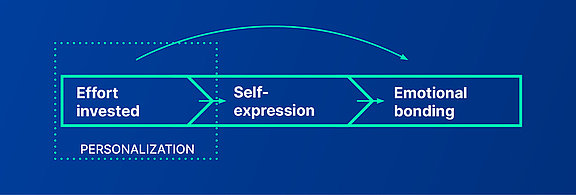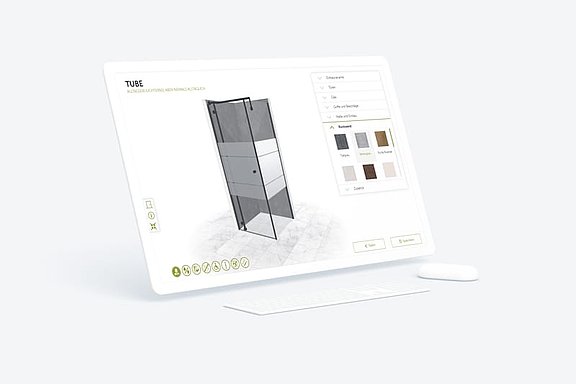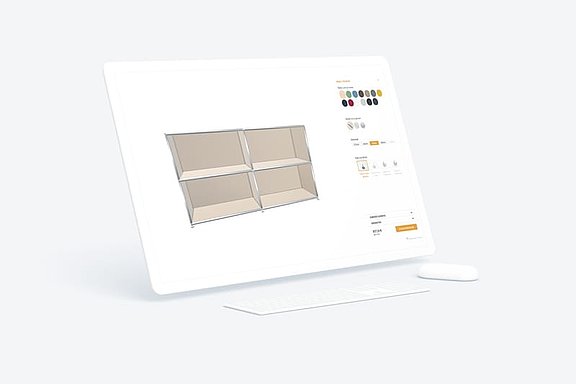How to create emotional products!
There are many reasons for an emotional attachment to a product. But one in particular stands out: the desire to design something oneself, to personalize it, to individualize it or - in other words - the desire to own something unique and thereby also feel special. Scientists have discovered that our buying behavior is shaped by emotions. A person does not buy a product, but an emotional feeling. This is where the 3D configurator enters the picture, it is an excellent tool to create a sustainable connection to customers on an emotional level.
Why do customized products have more emotional benefits for us?
The relationship between customization and emotional bonding was investigated in the study "Emotional bonding with customized products". Dutch students were surveyed, all of whom owned a bicycle. Some, however, had individualized their bicycles, painted them conspicuously, decorated them with a pattern, bright colors or names. The reason: a bicycle that stands out visually on a campus full of bicycles is easier for the owner to find and is also less likely to be stolen. And most importantly, a unique bike underlines one's own personality.
In fact, the individualized bicycles had a higher emotional value for their owners. And what's more: the more elaborate the individualization, the stronger the emotional appreciation. The big question for many companies at this point is: What does this knowledge do for my company?

How do companies benefit from emotional products?
The dynamics of a free, global market, technological progress and digitization brings a huge selection of equivalent, standardized, interchangeable products. Often these products cannot even be differentiated by price. Therefore it is obvious for customers to look for other indications and values for their purchase decisions. And this is when the emotional dimension of product customization described above comes into play. Because companies as well are constantly looking for new ways to emotionally involve, bind and make customers loyal. This makes emotional marketing or an emotional brand increasingly important.
Particularly interesting: Loyal and emotionally attached customers cause fewer costs in relationship management and marketing. They are less sensitive to price fluctuations, buy more and more often, and create a long-term connection to the brand.
Do configurators create products with emotions?
Yes, because thanks to high-performance configurators, the range of products that can be customized has increased massively in recent years. This applies to the B2C market as well as to the B2B market. Customers want to buy products that satisfy their desire for uniqueness. Configurators make exactly that possible. They are the interface between product and buyer. If the customization process is user-friendly and professionally implemented, they offer enormous potential for emotionally charging users.
Successful examples of configurators:

What does individualization trigger in us emotionally?
"I did it myself, it's mine and it's great!" The possibility of influencing the shape, appearance and texture of an object creates an emotional bond due to an unconsciously experienced ownership claim. This phenomenon is known as the endowment effect:
- If I can influence the end result of a product, it gives me the feeling that it belongs to "me" even without legal ownership.
- I am in control of the final look of a product and that strengthens my ownership.
- The interaction with the product during my customization the realistic visualization of the product give me the illusion of being able to touch it. This signals to my brain how nice it would be if the product actually was “mine”.
- The very feeling that something belongs to me increases my appreciation for this product.
The emotional chain of effects during configuration is ideal: Customers customize a product and, in the process unconsciously develop feelings of possessiveness that lead them to ultimately buy the product even if they did not initially intend to do so. The key point is that all this happens unconsciously on an emotional level. The customers do not have any negative "Regret" feelings - on the contrary, a positive emotional relationship with the brand develops.
"I'm in the flow, I'm having fun, I want more!"
Another psychological effect is triggered by the creative process during configuration. The possibility to express yourself, to accomplish something, to find a solution to a task, conveys fun, joy, pride and satisfaction. Science describes this state as a flow experience: A flow describes the feeling of happiness, experienced as a mental state of complete immersion (concentration) and complete absorption in an activity that happens by itself.
What is similar to addictive behavior also happens intrinsically, i.e., from within, of one's own accord, and is conditioned by incentives inherent in the subject matter. A prerequisite for the emergence of a flow experience is that the task roughly corresponds to the user's abilities. If the challenge is too great, it can quickly lead to frustration; if it is too low, it can become boring. Pride also plays a role in this context: mastering a system and designing the best or most suitable product can create a positive feeling. This success (the product is fully configured and fits perfectly) leads in turn to deep satisfaction.

Is there anything to consider?
There is no question about the fact that configurators trigger emotions. However, they are influenced by the usability and quality of the configurator as the interaction platform. When implementing configurator projects, companies often tend to offer a too big range of customization variables. The problem: a high number of variations does not provoke positive emotions for every user. In the search for the optimal middle, it helps to look at the concept of Paradox of Choice.
Where emotions are involved, one must not generalize. People are different and do not react uniformly. What is a challenge and fun for one person is boring for the next and unconsciously triggers fears in the third. Therefore, a detailed analysis of the target group and the buyer personas is absolutely crucial for the positive response to a configurator. It is often useful to publish a "light version" of the configurator and gradually add more options. This makes it very easy to determine the acceptance of the new set of options. For more in-depth information, take a look at the blog article: Creating configurators successfully.
How emotional are B2B customers?
While the general opinion in the B2C area is that customers act on the basis of emotions and only justify decisions with logic afterwards, the situation is different in the B2B area. Purchasing decisions in the B2B area, so the assumption, are primarily made rationally and fact-based. This is because the procurement process between companies is complex, characterized by requirements, dependencies, longer time spans and by multiple decision-makers.
But in the end, people are also involved here. The motive and emotion system is the essential force according to which purchasing decisions are influenced and made. We do not discard this system when we start our daily work routine. Rather, it influences our decisions in the B2B context as well. Thus, the current State of B2B Study 2019 also comes to the conclusion that the final B2B purchase decision is influenced by emotional criteria to 56%.
Conclusion: Emotional marketing is the future, because people buy emotions and not products. An efficient tool here is undoubtedly an online store configurator for your website. Especially your sales, marketing and brand benefit immensely from emotional product staging. Configurations create a unique shopping experience for your customers on your website and as a result an immense competitive advantage.
This might also interest you: